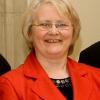It is very common to describe Advent as a season of “waiting.” But, what does that word “waiting” mean to me? What experiences spring to mind as the big waiting times in my life: waiting for medical test results, waiting for a friend to return from travels overseas, waiting in an airport during a snow storm when flights get delayed, waiting for a gift to arrive in the post? Each of these experiences of waiting has a different atmosphere. For some there is an anxious character to the period of expectation, and for others the atmosphere is one of joyful anticipation.
Given all the different reminders that the word “waiting” carries, we must look afresh at what the meaning of waiting in the Advent season might be. As we know, it is the birth of Mary of Nazareth’s first child that is the concrete historical experience that sets the scene for Advent waiting. Awaiting a birth draws the woman who is pregnant into the experience of waiting at every level of being: The body produces daily reminders of forthcoming events; the mind actively plans arrangements in life and home for the new arrival; the spirit harbors joys, anxieties and hopes in the context of the awaited birth.
How rich a season Advent is! All dimensions of our being are being drawn into the experience of actively waiting for the dawning of a new awakening to the presence of Mystery in our midst. To enter into the spirit of Advent waiting is to invite the body into a lived presence to the mystery of God in our world, whether by spending time with those in vulnerable or fragile life circumstances or by reaching out to those made poor by homelessness or traumatic life events. Our busy-ness and planning are invited to alignment with the profound character of the Mystery we await. In the Advent season we attend to the deepest yearnings and desires which are moving in our inner being.
But as well stirring body, mind and spirit, Advent invites the soul to a new awakening. It is a mystical moment in the annual cycle of liturgical time. An invitation is issued to wait again with hopeful anticipation for the ever new action of God in our world. We are invited to take hold of our fragility, pain, brokenness, limitations and despair and to invoke the light that does not fail, the hope that defies our small expectations, the joy that does not pass into the recesses of our souls.
Solitude can facilitate the emergence and growth of soulful living in Advent. Solitude is more an attitude than an environment, a lived belief in the need for regular withdrawal to the inner room of each one’s being, through practices like journal writing, chanting, circle dancing or hill walking which activate a different consciousness even in the midst of a crowd. Time spent in that inner monastery of being through reflective practices allows what has become muddied and confused in daily living to settle and become clear.
In the spirit of Leonard Cohen’s song, “The Tower of Song,” God is calling each one from within, to come home to the unique desire that has been placed in each heart by God. We seek to learn the mystery of God’s desiring coming to birth in our hearts, the truth of our life and being. Only in solitude can the music to which one is called to dance be heard. It is not effort and striving that makes a person genuine. The soul’s voluntary re-alignment to its inner whispered name is the most essential act of abandonment into the creative energy of God each Advent. The ear of the heart seeks attentively to hear the unique name by which the spirit of being is called forth from a shadowy existence of accepted confinement into the vibrancy of life in abundance.
The heart which embraces waiting in creative solitude this Advent will be opened to dimensions of reality that previously were unnoticed. When the flow of life is embraced by solitude, eyes become more adept at noticing the hints of Presence since all existence sails in the sea of divine upholding. While embracing solitude seems at first to exclude, as Advent unfolds it becomes clear that this sea sustains those who swim and dive and sail and float. In the place of solitude, we see the face of God in all who live and love.
[Bernadette Flanagan is a Sister of the Presentation of the Blessed Virgin Mary who has been director of research at All Hallows College (Dublin City University) since 2008. Her publications include, "Quaestio Divina: Research as Spiritual Practice" in (The Way, Nov. 2014); Embracing Solitude: Women and New Monasticism (2013) and (with Michael O'Sullivan SJ, eds,) Spiritual Capital: Christian Spirituality in Applied Perspective (2012).]
